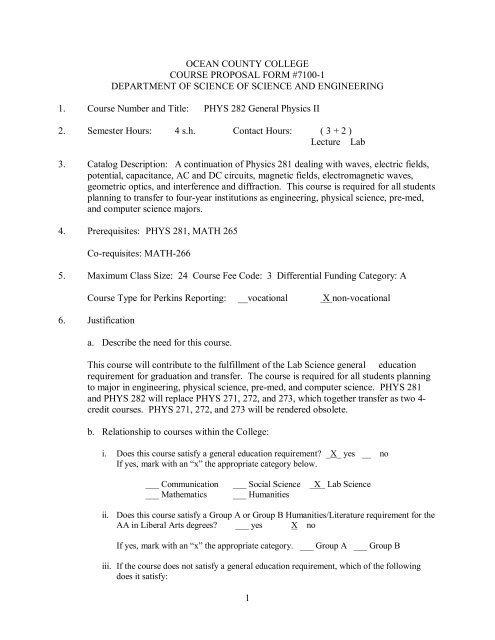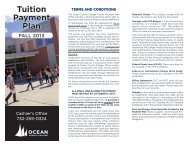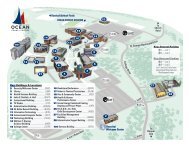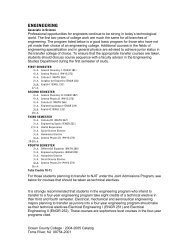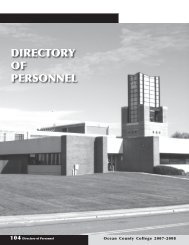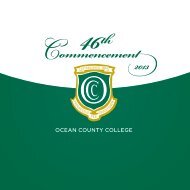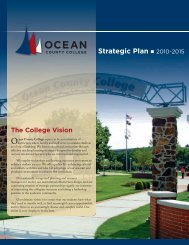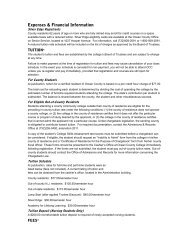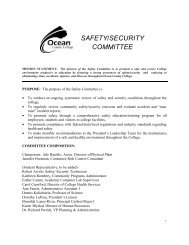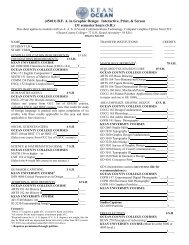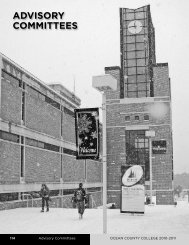Course Syllabus for PHYS 282 - Ocean County College
Course Syllabus for PHYS 282 - Ocean County College
Course Syllabus for PHYS 282 - Ocean County College
You also want an ePaper? Increase the reach of your titles
YUMPU automatically turns print PDFs into web optimized ePapers that Google loves.
OCEAN COUNTY COLLEGE<br />
COURSE PROPOSAL FORM #71001<br />
DEPARTMENT OF SCIENCE OF SCIENCE AND ENGINEERING<br />
1. <strong>Course</strong> Number and Title: <strong>PHYS</strong> <strong>282</strong> General Physics II<br />
2. Semester Hours: 4 s.h. Contact Hours: ( 3 + 2 )<br />
Lecture Lab<br />
3. Catalog Description: A continuation of Physics 281 dealing with waves, electric fields,<br />
potential, capacitance, AC and DC circuits, magnetic fields, electromagnetic waves,<br />
geometric optics, and interference and diffraction. This course is required <strong>for</strong> all students<br />
planning to transfer to fouryear institutions as engineering, physical science, premed,<br />
and computer science majors.<br />
4. Prerequisites: <strong>PHYS</strong> 281, MATH 265<br />
Corequisites: MATH266<br />
5. Maximum Class Size: 24 <strong>Course</strong> Fee Code: 3 Differential Funding Category: A<br />
<strong>Course</strong> Type <strong>for</strong> Perkins Reporting: __vocational X nonvocational<br />
6. Justification<br />
a. Describe the need <strong>for</strong> this course.<br />
This course will contribute to the fulfillment of the Lab Science general education<br />
requirement <strong>for</strong> graduation and transfer. The course is required <strong>for</strong> all students planning<br />
to major in engineering, physical science, premed, and computer science. <strong>PHYS</strong> 281<br />
and <strong>PHYS</strong> <strong>282</strong> will replace <strong>PHYS</strong> 271, 272, and 273, which together transfer as two 4<br />
credit courses. <strong>PHYS</strong> 271, 272, and 273 will be rendered obsolete.<br />
b. Relationship to courses within the <strong>College</strong>:<br />
i. Does this course satisfy a general education requirement? _X_ yes __ no<br />
If yes, mark with an “x” the appropriate category below.<br />
___ Communication ___ Social Science _X_ Lab Science<br />
___ Mathematics ___ Humanities<br />
ii. Does this course satisfy a Group A or Group B Humanities/Literature requirement <strong>for</strong> the<br />
AA in Liberal Arts degrees? ___ yes X no<br />
If yes, mark with an “x” the appropriate category. ___ Group A ___ Group B<br />
iii. If the course does not satisfy a general education requirement, which of the following<br />
does it satisfy:<br />
1
___ Programspecific requirement <strong>for</strong> the following degree program:<br />
__________________________________________________<br />
__ Elective<br />
iv. Does this course satisfy the diversity requirement <strong>for</strong> the AA in Liberal Arts degree?<br />
___ yes<br />
X no<br />
[The diversity requirement is defined as “any course whose primary purpose is to<br />
help students analyze the implications of the commonalities and differences<br />
among culturally diverse people(s). This requirement may include courses in<br />
gender studies or in nonwestern history and thought.”]<br />
If yes, please explain: ______________________________________________<br />
v. Does this course satisfy the computer literacy requirement? ___ yes X no<br />
c. Related courses in other institutions:<br />
[NOTE: The two charts below need to be completed when submitting a new<br />
course proposal. They do not need to be completed <strong>for</strong> most course revisions,<br />
unless an Official <strong>Course</strong> Description is so old that the course’s transferability<br />
needs to be reconsidered, as in the case of an obsolete course which may be<br />
reactivated.]<br />
i. List any comparable course(s) by completing the table below. Insert “None” if<br />
there are no comparable courses.<br />
Institution<br />
Brookdale<br />
CC<br />
Mercer<br />
CC<br />
Comparable <strong>Course</strong>s at NJ Community <strong>College</strong>s<br />
<strong>Course</strong> <strong>Course</strong> Number<br />
Comments<br />
Title Number Of Credits<br />
122 4 “introductory physics <strong>for</strong> students<br />
majoring in science or<br />
engineering. The student will<br />
employ the calculus in the<br />
development of the basic concepts<br />
of electrostatics, DC circuits,<br />
magnetism, magnetic induction,<br />
AC circuits, light and optics.”<br />
General<br />
Physics II<br />
University<br />
Physics II<br />
217 4 “Second course in a threesemester<br />
calculusbased sequence. Covers<br />
principles of electricity and<br />
magnetism: Coulomb's Law, the<br />
electric field, electrical potential,<br />
dialectrics and capacitance,<br />
resistivity, magnetic <strong>for</strong>ce and<br />
magnetic field, induction,<br />
accelerators, the magnetic properties<br />
of matter, DC and simple AC circuits.<br />
Includes Maxwell's equations and<br />
radiation.”<br />
2
Raritan<br />
Valley CC<br />
Engineering<br />
Physics II<br />
Burlington General<br />
CC Physics II<br />
Morris CC Engineering<br />
Physics II<br />
Bergen<br />
CC<br />
151 4 “The second semester of a threesemester<br />
sequence in introductory<br />
physics which is required <strong>for</strong><br />
students majoring in the<br />
engineering sciences. Also highly<br />
recommended <strong>for</strong> transfer students<br />
majoring in the physical sciences.<br />
Topics studied include electric and<br />
magnetic <strong>for</strong>ces and fields, direct<br />
and altering current circuits and<br />
components, and Maxwell’s<br />
equations.”<br />
212/213 3+1 No description available<br />
133/134 4+1 “This is the second course of a<br />
threesemester, calculusbased<br />
physics sequence. Topics include<br />
simple harmonic motion, waves,<br />
electromagnetic theory and<br />
applications, Maxwell’s equations<br />
in integral <strong>for</strong>m.”<br />
Physics II 290 4 “This course is the continuation of<br />
PHY280 Physics I, and is<br />
primarily a study of electricity and<br />
magnetism. It covers electrostatics,<br />
electrical circuits, magnetic fields<br />
and <strong>for</strong>ces, capacitance and<br />
inductance, Maxwell’s equations,<br />
and the properties of fluids”<br />
ii. If “None” was inserted, please explain.<br />
iii. Complete the table below. The institutions listed comprise the top six institutions<br />
queried on NJTransfer by OCC students.<br />
Institution<br />
Rutgers New<br />
Brunswick<br />
Georgian Court<br />
University<br />
Richard Stockton<br />
<strong>College</strong><br />
Monmouth<br />
University<br />
Kean<br />
University<br />
Transferability of Proposed <strong>Course</strong><br />
Transfer Category<br />
(Major, General<br />
Ed., or Elective)<br />
<strong>Course</strong> Code,<br />
Title,<br />
And Credits<br />
Phys 204<br />
Gen Phys II<br />
PH 122Gen<br />
Phys II<br />
Phys 2230<br />
Gen Phys II<br />
PH 212 Gen<br />
Phys w/Calc<br />
Phys 2096<br />
Physics II<br />
General Ed<br />
Major, General Ed<br />
Major, General Ed<br />
Major, General Ed<br />
Major, General Ed<br />
Will NOT<br />
Transfer<br />
(Place an<br />
“x” in box)<br />
Unable to<br />
Determine<br />
Status (Place<br />
“U” in box)<br />
3
Rowan<br />
University<br />
NJIT<br />
Rutgers<br />
Engineering<br />
PH 201 Major, General Ed<br />
Phys II<br />
Phys 121 and Major, General Ed<br />
121A Phys II<br />
Phys II Phys 124<br />
iv. If a “U” was inserted above, document the course transferability by providing<br />
either (a) the name of a contact person at the fouryear institution, or (b) an email<br />
from the contact person (attach to this proposal).<br />
v. If not transferable to any institution, explain.<br />
d. Consistency with the vision and mission statements, the Academic Master Plan, and the<br />
strategic initiatives of the <strong>College</strong>.<br />
This course addresses the <strong>College</strong>’s vision, mission, and Academic Master Plan by<br />
(1) Demonstrating the college’s commitment to offer comprehensive educational<br />
programs that develop intentional learners of all ages. (Mission Statement)<br />
(2) Seeking to ensure that students will thrive in an increasingly diverse and complex<br />
world. (Vision Statement)<br />
(3) Preparing students <strong>for</strong> successful transfer to other educational institutions and/or <strong>for</strong><br />
entrance into the work<strong>for</strong>ce. (Academic Master Plan)<br />
(4) Seeking to empower students through the mastery of intellectual and Practical Skills.<br />
(Academic Master Plan)<br />
(5) Challenging students to transfer in<strong>for</strong>mation into knowledge and knowledge into<br />
action. (Academic Master Plan)<br />
e. Mark with an “x” the General Education goal(s) addressed by this course:<br />
X 1. Independent Thinking X 5. Science & Social Science X 9. Global Perspective<br />
X 2. Communication _ 6. Aesthetic Appreciation _ 10. Health & Well Being<br />
X 3. Problem Solving _ 7. Historical Consciousness _ 11. Civic Responsibility<br />
X 4. Ethical Judgment _ 8. Diversity X 12. Technology<br />
_ 13. Lifelong Learning<br />
7. Specific <strong>Course</strong> Learning Objectives:<br />
Students who successfully complete this course will be able to:<br />
1. Explain the fundamental concepts, laws, and relationships of waves, dc and<br />
ac circuits, electric and magnetic fields, inductance, light, and geometric optics.<br />
. 2. Demonstrate a working knowledge of the instruments and techniques of scientific<br />
inquiry including the calibration, use, and critical analysis of the results.<br />
3. Demonstrate the skills necessary <strong>for</strong> scientific inquiry including the application of<br />
mathematics through differential and integral calculus.<br />
4
8. Methods of Instruction: Lecture/Discussion and Laboratory<br />
9. Instructional Materials:<br />
An appropriate text will be selected. Contact the department <strong>for</strong> current adoptions.<br />
A pocket calculator with trigonometric functions.<br />
Optional Materials: None<br />
10. Tentative Topical Outline:<br />
11. Grade Determinants:<br />
<strong>Course</strong> Topic & Chapter<br />
Week<br />
1 Electric Forces<br />
2 Electric Fields<br />
3 Electric Potential<br />
4 Capacitance<br />
5 Current<br />
6 DC Circuits<br />
7 Magnetic Field & Force<br />
8 Faraday’s Law<br />
9 Electromagnetic Induction<br />
10 Electromagnetic Waves<br />
11 Electromagnetic Waves<br />
12 Reflection & Refraction<br />
13 Image Formation<br />
14 Wave Optics<br />
15 Interference & Diffraction<br />
The final grade in this course will be the cumulative grade based on the following letter<br />
grades or their numerical equivalents <strong>for</strong> the course assignments and examinations:<br />
A Excellent C Average I Incomplete<br />
B+ Very Good D Below Average W Withdrawn<br />
B Good F Failure R Audit<br />
C+ Above Average P Passing NC No Credit<br />
12. Number of Papers and Examinations:<br />
A minimum of three major examinations and weekly written lab assignments.<br />
5
APPROVAL PROCESS FOR A REVISED COURSE PROPOSAL (SYLLABUS)<br />
Revision of the Following Items Must Be<br />
Sent to the Curriculum Committee<br />
Revision of the Following Items<br />
Require No Approval<br />
#1 <strong>Course</strong> Number & Title #8 Methods of Instruction<br />
#2 Semester Hours/Contact Hours #9 Instructional Materials<br />
#3 Catalog Description #10 Tentative Topic Outline<br />
#4 Prerequisites & Co requisites #11 Grade Determinants<br />
#5 Maximum Class Size/Lab Fee Code/ #12 Number of Papers and Examinations<br />
Differential Funding Category<br />
#6 Justification<br />
#7 <strong>Course</strong> Objectives<br />
6


